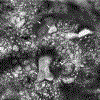Reflectance confocal microscopy-guided carbon dioxide laser ablation of low-risk basal cell carcinomas: A prospective study
- PMID: 31202871
- PMCID: PMC6777957
- DOI: 10.1016/j.jaad.2019.06.014
Reflectance confocal microscopy-guided carbon dioxide laser ablation of low-risk basal cell carcinomas: A prospective study
Abstract
Background: Basal cell carcinoma (BCC) treatment modalities can be stratified by tumor subtype and recurrence risk. The main limitation of nonsurgical treatment modalities is the lack of histopathologic confirmation. Reflectance confocal microscopy (RCM) is a noninvasive imaging device that provides quasihistologic images.
Objective: To evaluate the feasibility and efficacy of RCM-guided carbon dioxide (CO2) laser ablation of low-risk BCCs.
Methods: Prospective study with biopsy specimen-proven low-risk BCCs imaged with RCM. RCM was performed on these sites before and after ablation. If residual tumor was found, a new series of laser passes were performed. The patients were then monitored for recurrence clinically and with RCM.
Results: Twenty-two tumor sites in 9 patients (5 men, 4 women) were imaged and treated. Median age was 59 ± 12.9 years (range, 30-74 years). Mean tumor size was 7.7 mm (range, 5-10 mm). Residual tumor was identified in 5 of 22 cases (22.7%) under RCM on immediate first-pass postablation sites, prompting additional laser passes. Median follow-up was 28.5 months (range, 22-32 months) with no recurrences found.
Conclusions: Addition of RCM to laser ablation workflow can detect subclinical persistent tumor after initial ablation and may serve as an aid to increase the efficacy of laser ablation.
Keywords: ablation; basal cell carcinoma; carbon dioxide laser; diagnosis; follow-up; laser; reflectance confocal microscopy; treatment.
Copyright © 2019 American Academy of Dermatology, Inc. Published by Elsevier Inc. All rights reserved.
Conflict of interest statement
Conflict of interest:
Figures


Similar articles
-
Carbon dioxide laser ablation of basal cell carcinoma with visual guidance by reflectance confocal microscopy: a proof-of-principle pilot study.Br J Dermatol. 2016 Jun;174(6):1359-64. doi: 10.1111/bjd.14414. Epub 2016 Apr 19. Br J Dermatol. 2016. PMID: 26800657 Free PMC article.
-
Confocal imaging of carbon dioxide laser-ablated basal cell carcinomas: An ex-vivo study on the uptake of contrast agent and ablation parameters.Lasers Surg Med. 2016 Feb;48(2):133-9. doi: 10.1002/lsm.22415. Epub 2015 Sep 22. Lasers Surg Med. 2016. PMID: 26392001 Free PMC article.
-
Reflectance confocal microscopy confirms residual basal cell carcinoma on clinically negative biopsy sites before Mohs micrographic surgery: A prospective study.J Am Acad Dermatol. 2019 Aug;81(2):417-426. doi: 10.1016/j.jaad.2019.02.049. Epub 2019 Jun 19. J Am Acad Dermatol. 2019. PMID: 31227277 Free PMC article.
-
Laser Treatment for Non-Melanoma Skin Cancer: A Systematic Review and Meta-Analysis.Am J Clin Dermatol. 2021 Jan;22(1):25-38. doi: 10.1007/s40257-020-00562-8. Am J Clin Dermatol. 2021. PMID: 32930983
-
The Role of Reflectance Confocal Microscopy in Clinical Trials for Tumor Monitoring.Dermatol Clin. 2016 Oct;34(4):519-526. doi: 10.1016/j.det.2016.06.001. Dermatol Clin. 2016. PMID: 27692458 Review.
Cited by
-
In vivo imaging characterization of basal cell carcinoma and cutaneous response to high-dose ionizing radiation therapy: A prospective study of reflectance confocal microscopy, dermoscopy, and ultrasonography.J Am Acad Dermatol. 2021 Jun;84(6):1575-1584. doi: 10.1016/j.jaad.2020.07.130. Epub 2020 Aug 20. J Am Acad Dermatol. 2021. PMID: 32827607 Free PMC article. Clinical Trial.
-
Optical imaging guided- 'precision' biopsy of skin tumors: a novel approach for targeted sampling and histopathologic correlation.Arch Dermatol Res. 2021 Sep;313(7):517-529. doi: 10.1007/s00403-020-02126-6. Epub 2020 Aug 25. Arch Dermatol Res. 2021. PMID: 32844312 Free PMC article.
-
Management of complex head-and-neck basal cell carcinomas using a combined reflectance confocal microscopy/optical coherence tomography: a descriptive study.Arch Dermatol Res. 2021 Apr;313(3):193-200. doi: 10.1007/s00403-020-02037-6. Epub 2020 Feb 4. Arch Dermatol Res. 2021. PMID: 32020324 Free PMC article.
-
Confocal Microscopy for Diagnosis and Management of Cutaneous Malignancies: Clinical Impacts and Innovation.Diagnostics (Basel). 2023 Feb 23;13(5):854. doi: 10.3390/diagnostics13050854. Diagnostics (Basel). 2023. PMID: 36899999 Free PMC article. Review.
-
Reflectance confocal microscopy terminology glossary for melanocytic skin lesions: A systematic review.J Am Acad Dermatol. 2021 Jan;84(1):102-119. doi: 10.1016/j.jaad.2020.05.097. Epub 2020 May 23. J Am Acad Dermatol. 2021. PMID: 32454102 Free PMC article.
References
-
- National Comprehensive Cancer Network N. Basal Cell Skin Cancer (Version 1.2018) 2018.
-
- Mirza FN, Khatri KA. The use of lasers in the treatment of skin cancer: A review. J Cosmet Laser Ther 2017;19:451–8. - PubMed
-
- Zane C, Facchinetti E, Arisi M, Ortel B, Calzavara-Pinton P. Pulsed CO2 Laser Ablation of Superficial Basal Cell of Limbs and Trunk: A Comparative Randomized Clinical Trial With Cryotherapy and Surgical Ablation. Dermatol Surg 2017;43:920–7. - PubMed
-
- Telfer NR, Colver GB, Morton CA, British Association of D. Guidelines for the management of basal cell carcinoma. Br J Dermatol 2008;159:35–48. - PubMed
-
- Kadouch DJ, Schram ME, Leeflang MM, Limpens J, Spuls PI, de Rie MA. In vivo confocal microscopy of basal cell carcinoma: a systematic review of diagnostic accuracy. J Eur Acad Dermatol Venereol 2015;29:1890–7. - PubMed
MeSH terms
Grants and funding
LinkOut - more resources
Full Text Sources
Medical

